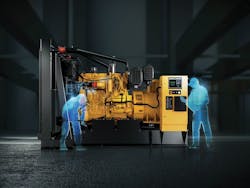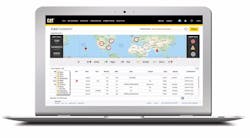Remote Monitoring for Distributed Power Generation
With its Cat Connect technology, users “can monitor an essentially unlimited number of gensets at sites around the world and display them all in a single dashboard view,” says Magy Kramer, digital and technology marketing manager at Caterpillar. She explains that, in developing Cat Connect, Caterpillar was mindful of the distinctions between SCADA (supervisory control and data acquisition) system and remote monitoring technology when considering what it wanted to deliver to users of the technology. “Cat Connect can synthesize data across multiple sites and geographic areas and help users compare the performance of sites and individual assets,” Kramer says. “An entire year of data is retained for trending and analysis. In addition, data can be archived for up to 10 years, enabling users to compile extensive reports for compliance documentation or for internal and external audits.”
This level of data collection and storage significantly exceeds the capability of SCADA.
“Typically, a SCADA system exists inside the facility firewall; there is limited ability to extract data to the outside and to monitor and compare gensets across multiple sites,” Kramer explains. “The ability to trend data over time is also limited, usually to about 30 days. The primary function of SCADA is basic control and the setting of limits for alerts and alarms.” Remote monitoring also lets users combine machine data with business data for making operating decisions that can contribute to a company’s strategic goals. Kramer says this is possible because remotely collected data can be fed to a web-based asset monitoring application for analysis to help drive business insight. “Remote monitoring can also help distributed generators deal with the coming wave of retirements among domain experts in power facilities,” she says, “because it enables a smaller number of skilled people to exert control and provide support across multiple facilities and large geographies.”
Explaining how Cat Connect works, Kramer says machine data stored in a genset controller is translated by a configuration file into language that can be read by the Cat Connect. “A telematics device then sends the data to the application as often as once per second for the operators to view and analyze,” she adds. “Connecting a current Caterpillar genset controller to the remote monitoring application is generally a simple half-hour to four-hour procedure. However, connecting an older-generation controller, or another manufacturer’s controller, may require extra engineering to create the necessary configuration files because there is no single industry standard for remote monitoring in electric power applications. But once engineered, deployed, and tested, Cat Connect can monitor a genset fleet of essentially unlimited size with units of different ages and from a diverse mix of manufacturers.”
Beyond the delivery of equipment data insights to users anywhere in the world, Kramer contends the potential for remote monitoring also extends into collaborative troubleshooting and other problem-solving applications with the help of augmented reality (AR) and virtual reality (VR) technologies.
“VR and AR help users process and contextualize data by presenting it in three dimensions,” she explains. “In remote troubleshooting, for example, it is already possible for an engineer at a remote monitoring provider to have a digital twin of a genset on screen, overlaid with machine data. Meanwhile, a technician stands in front of the physical genset, but with a matching 3D image on a tablet computer, again with machine data overlaid. This kind of collaboration can significantly help the two parties talk through, contextualize, and solve problems.”
Caterpillar has been exploring the use of AR and VR extensively over the past few years. You can read more about the company’s exploration of these technologies in our coverage of Caterpillar’s use of smart connected products with AR and VR tools to transform how the company services equipment and interacts with its customers.
About the Author
David Greenfield, editor in chief
Editor in Chief

Leaders relevant to this article:

